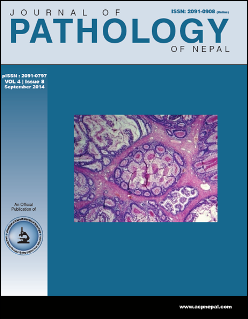A clinicopathological study of dysfunctional uterine bleeding
DOI:
https://doi.org/10.3126/jpn.v4i8.11500Keywords:
Uterine bleeding, Histopathology.Abstract
Background: Dysfunctional uterine bleeding is a form of abnormal uterine bleeding when there is absence of organic disease of the genital tract. The objective of this study was to find out the clinical and pathological aspect of women presenting with dysfunctional uterine bleeding.
Materials and Methods: A descriptive study was conducted over a period of one year from April 14th 2010 to April 13th 2011 in the Department of Obstetrics and Gynaecology and Department of Pathology, Tribhuvan University Teaching Hospital, Kathmandu, Nepal. A complete history, clinical examination, pelvic scan, hormonal status if required and endometrial biopsy were done to diagnose dysfunctional uterine bleeding.
Results: A total of 120 cases were included. The age of the patients diagnosed dysfunctional uterine bleeding were ranging from 24 -63 years. Dysfunctional uterine bleeding was most common in the age group 40-44 yrs (30%) followed by 45-49 yrs (27.5%). Menorrhagia (41.7%) was the most common presenting sign. Majority histopathology of endometrium revealed anovulatory pattern (61.7%) followed by ovulatory (38.3%). Of the cases with an anovulatory pattern 48.6% was proliferative endometrium, 33.8% disordered proliferative endometrium, 6.8%atrophic, 5.4% weakly proliferative and 2.7% each of simple hyperplasia without atypia and complex hyperplasia with atypia. All cases with ovulatory pattern showed secretory endometrium.
Conclusion: Dysfunctional uterine bleeding was the most common in the perimenopausal age group and chiefly in the form of an anovulatory endometrium. . Histopathological evaluation of endometrium helps exclude the local causes and establishes the diagnosis of dysfunctional uterine bleeding, its types, and clinical correlation to histopathological findings and finally helps to determine the mode of management.
DOI: http://dx.doi.org/10.3126/jpn.v4i8.11500
Journal of Pathology of Nepal; Vol.4,No. 8 (2014) 635-638
Downloads
Downloads
Published
How to Cite
Issue
Section
License
This license enables reusers to distribute, remix, adapt, and build upon the material in any medium or format, so long as attribution is given to the creator. The license allows for commercial use.




